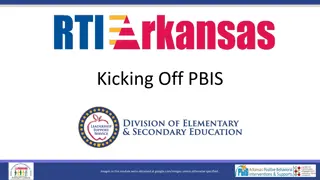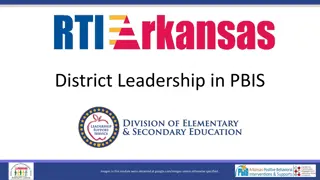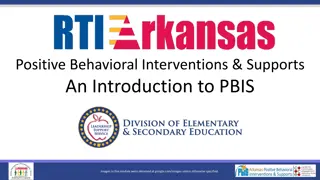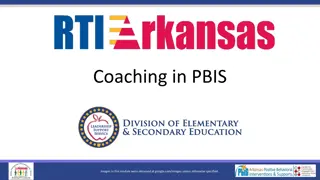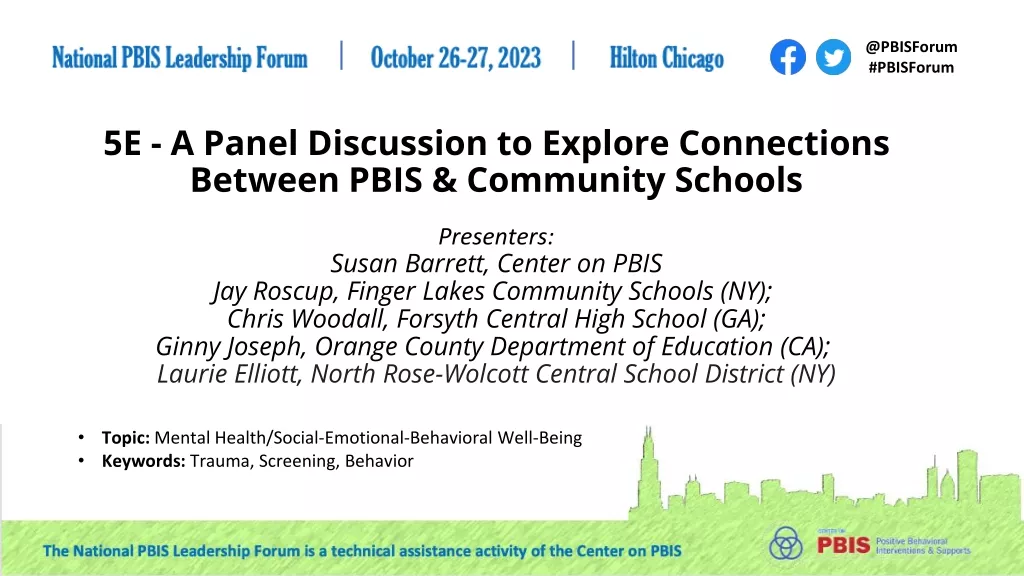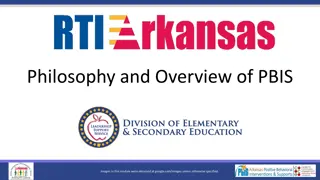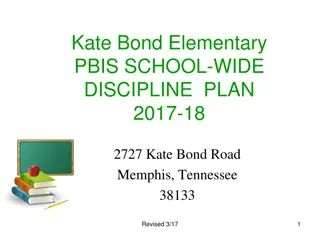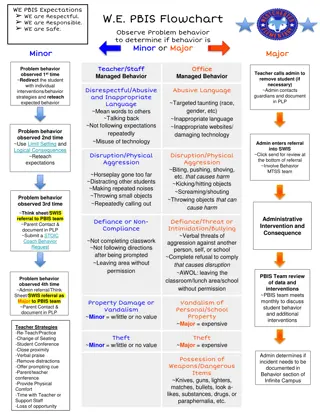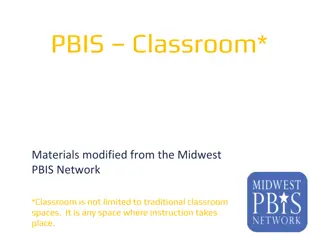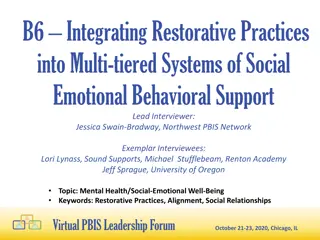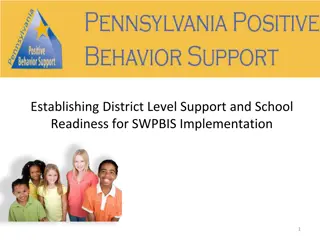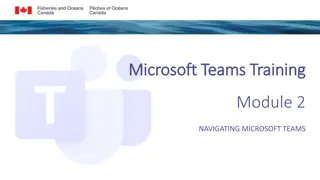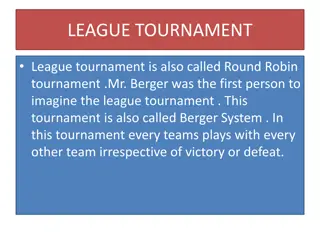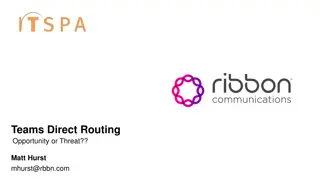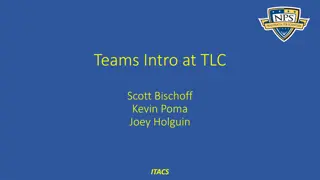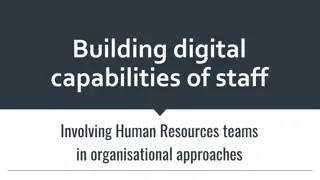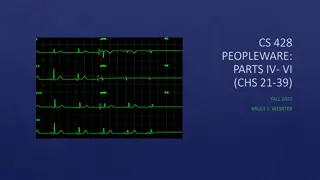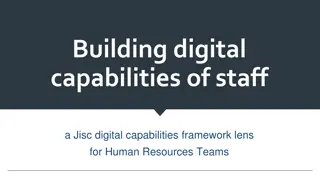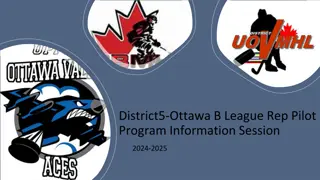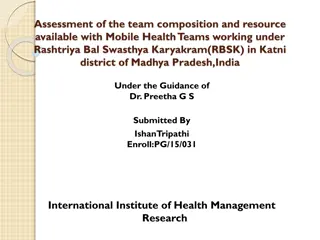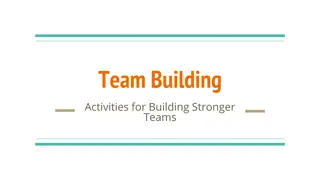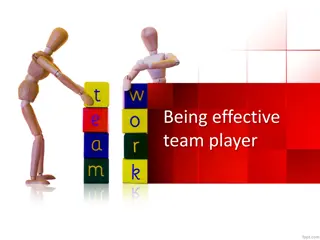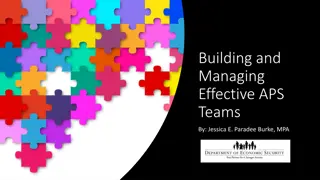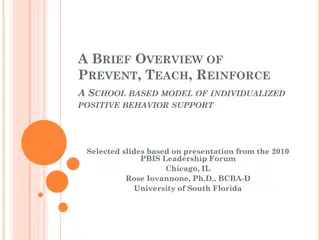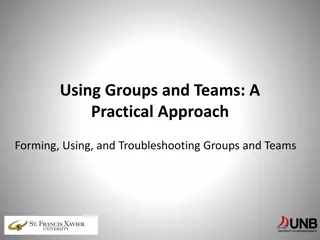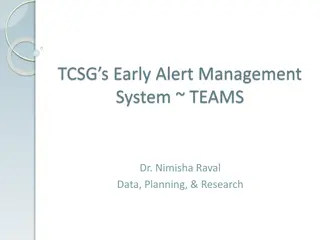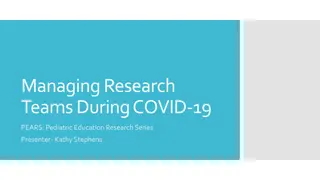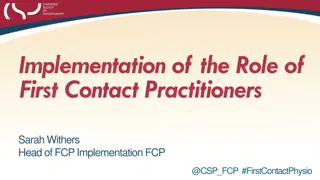Effective PBIS Implementation for School Teams
Explore critical elements of PBIS committees, data utilization, and problem-solving models for successful teamwork in schools. Learn about establishing PBIS committees, essential elements, leadership roles, and the importance of collaboration across various stakeholders. Identify session objectives, PBIS principles, and the significance of involving all school staff, parents, and community members in the PBIS process.
Download Presentation

Please find below an Image/Link to download the presentation.
The content on the website is provided AS IS for your information and personal use only. It may not be sold, licensed, or shared on other websites without obtaining consent from the author. Download presentation by click this link. If you encounter any issues during the download, it is possible that the publisher has removed the file from their server.
E N D
Presentation Transcript
CRITICAL ELEMENTS: PBIS COMMITTEES, DATA, AND PROBLEM SOLVING MODEL Myriam Tellez, Guidance & Counseling Director Effective teamwork begins and ends with communication. Mike Krzyzewski
Session Objectives: Identify Campus PBIS Committee Identify Data Sources Review a Problem Solving Model
What is PBIS? What are 2 things you already know about PBIS? What are 2 things you want to know more about with PBIS?
PBIS Essential Elements Dedicated teams to carry on the PBIS efforts in the building Sustained faculty commitment 3-5 school wide expectations (Be safe, Be Responsible, Be Respectful) Area specific rules with posters, i.e., gym, hallway, restrooms Classroom specific expectation matrix created by teacher and students Building T-Chart of Classroom vs. Office Managed Behaviors Positive behavior recognition/acknowledgement system maintained school-wide Building-wide and classroom lesson plans and system for teaching behavior Big 5 Data is analyzed monthly by PBIS Committee 10. PBIS language and practices supported throughout building 1. 2. 3. 4. 5. 6. 7. 8. 9.
PBIS Committee: Establishing a Foundation for Collaboration and Operation
POP Quiz Who is all needed to make PBIS effective at your school? Teachers Administrators Parents Police All of the above
Answer Everyone in your building is needed to make PBIS effective at your building
Who Should be on the PBIS Committee The Principal takes on the task of inviting staff to be on the PBIS team, identifying an effective, representative group of individual who will work well together to include: General & Special Ed Teachers Administrators Behavior Specialists Food Service Staff Paraprofessionals Bus Drivers Counselors / Social Workers Students Office Staff Parents Librarians / Media Specialists Community Member Coaches Other (as needed)
PBIS Team Main Tasks Develop the school-wide PBIS action plan Monitor behavior data Hold regular team meetings (at least monthly) Maintain communication with staff Evaluate progress Report outcomes to staff, students, and District
How Do We Develop Effective Teams? Hold regular meetings. Stick to the date. Hold each other accountable to be there on time. Establish roles for each member. Team Leader, Recorder, timekeeper, etc. Follow-up on tasks established at each meeting. Agendas reflect action items. 11
Data Specialist Recorder Time keeper Communications Manager Team Leader 12
Kinds of Data Office discipline reports Behavioral incidents Attendance Suspension/Detention Observations Self-assessments Surveys Olweus Bullying Prevention Program Survey Results Etc.
General Approach: Big 5 # referrals per day per month # referrals by student # referrals by location #/kinds of problem behaviors # problem behaviors by time of day
Data help us ask the right questionsthey do not provide the answers: Use data to Identify problems Refine problems Define the questions that lead to solutions Data help place the problem in the context rather than in the students.
Decisions are more likely to be effective and efficient when they are based on data. The quality of problem-solving depends most on the first step (defining the problem to be solved) Define problems with precision and clarity
Review Status and Identify Problems Team Initiated Problem Solving Model Evaluate and Revise Action Plan Develop and Refine Hypotheses Collect and Use Data Discuss and Select Solutions Develop and Implement Action Plan Problem Solving Foundations
Problem solving Mantra Do we have a problem? (Identify the primary problem) What is the precise nature of the problem? (Define, clarify, confirm/disconfirm inferences) Why does the problem exist, & what should we do about it? (Hypothesis & solution) What are the actual elements of our plan? (Action Plan what will we do, who will do it, when it get done) Is our plan being implemented? (Evaluate & revise plan) Is the plan having the desired effect? (Maintain, modify or terminate the plan)
Have you ever been a part of this committee meeting? No agenda is prepared Meeting starts late No time schedule has been set for the meeting No one is prepared No facilitator is identified No one agrees on anything No action plan is developed Everyone is off task Negative tone throughout the meeting https://youtu.be/ZXA-I8K0aUo
Questions? m.tellez@lajoyaisd.net 323-2175


